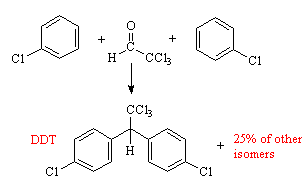 DDT
DDTDDT is the abbreviation for p,p-dichlorodiphenyltrichloroethane and it is probably the compound, above all others, that first sparked off concern for the possible adverse effects of chemicals on the environment.
Before about 1940, most of the insecticides used in agriculture were inorganic compounds made from arsenic, sulphur and various fluorides. These would be quite unacceptable by today's standards, since they are highly toxic to animals! In 1939, however, Paul Muller of the chemical company Geigy discovered that the chlorine-containing organic compound DDT (which had actually been first synthesised in 1873), was extremely effective in killing insects. This discovery won him the Nobel prize for medicine in 1948.
DDT is a remarkable molecule, since it kills a wide variety of insect pests, such as houseflies, body lice, mosquitoes, Colorado beetles, and gypsy moths. This activity is heightened by the fact that it has little or no toxicity to mammals or other animals, and is a very stable molecule that can be manufactured by a simple and cheap process. This process is almost the ideal organic synthesis - heat the reactants together in a single step, pour the reaction mixture into water and filter off the DDT, which can be used without further purification!

DDT first came into the public's attention in WW2 in 1943, when it was used by the US Army in Naples to stop a typhus epidemic. This is quite remarkable, when you realise that typhus killed 2.5 million Russians during WW2, and the use of this chemical had stopped it cold! It was then discovered that DDT could kill the mosquitoes which spread malaria, and DDT was then sprayed all over the world in malarial areas - at one time consuming 60,000 tons of DDT every year. This eradication program was remarkably successful - in India alone the number of deaths dropped from 500,000 in 1960 to only 1,000 by the 1970s. Worldwide, the number of malaria deaths has been reduced from 6,000,000 per year to less than 2,000,000 per year, entirely due to the success of DDT and other insecticides.
This was a result of two of the properties of the DDT molecule. First it was virtually insoluble in water, but very soluble in organic solvents and fats. Secondly, it is very stable, which is ironic since this stability was one of the advantages DDT had over other pesticides since it meant that the chemical did not have to be frequently reapplied. In the environment, therefore, DDT is slowly washed into rivers and streams, where it then enters the foodchain. It passes up the foodchain, concentrating in the fatty tissues as it does so. At every step up the foodchain, the relative concentration increases (see table).
| DDT concentration (ppm of body weight) | ||
|---|---|---|
 | Lake Water | 0.00002 |
 | Muds at the bottom of lakes | 0.014 |
 | Amphipods | 0.410 |
| Trout (and other fish) | 6 | |
 | Herring Gulls | 99 |
 | Peregrine Falcons | 5,000 |
DDT has no appreciable effect at concentrations below those seen in fish, but by the time it gets to the birds, particularly the falcons, the concentrations are now so high that even the relatively safe DDT molecule becomes toxic. This leads to serious health problems or even death. Because of these problems, and also the fact that DDT-resistant evolved, DDT was banned in the USA in 1973, and has since been banned in many other countries throughout the world. Alternative insecticides, made from organophosphates, are now used instead, but these cost up to 3 times as much as DDT.
It is important to remain objective on issues like these, since any emotional judgement of the environmental problems that DDT caused must be balanced by consideration of the great benefits which it brought to mankind, and the millions of lives it saved in the malaria eradication campaigns of the 1950s and 1960s. On balance, DDT has been of immense benefit to the world, however it still serves as a powerful reminder that any chemical introduced into the environment on a large scale should first be studied for any potential problems which may result.